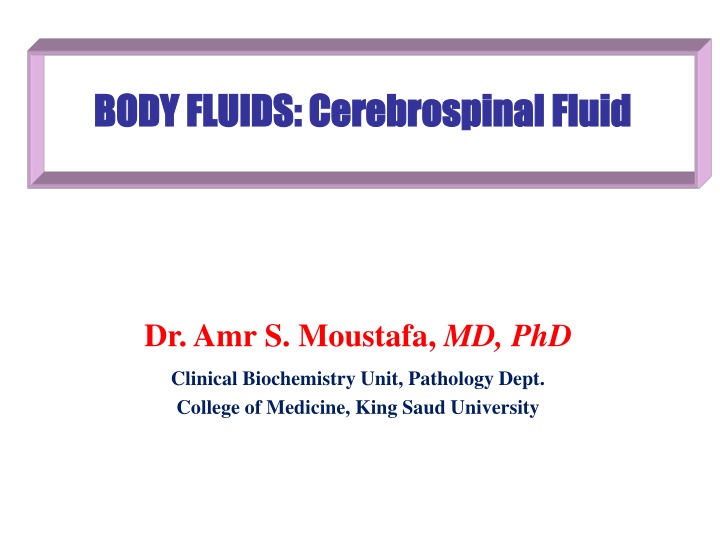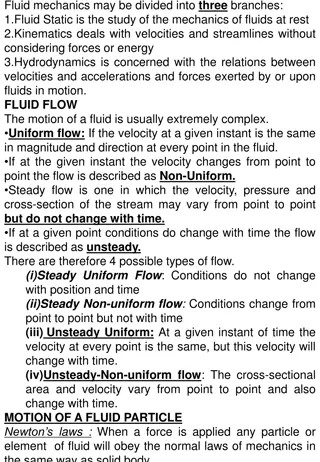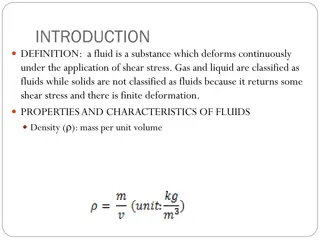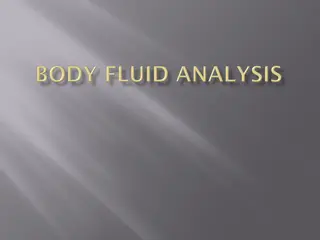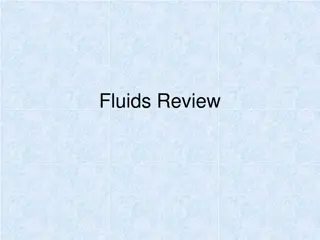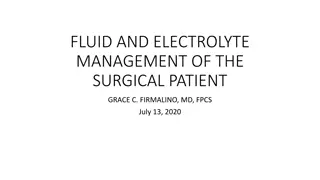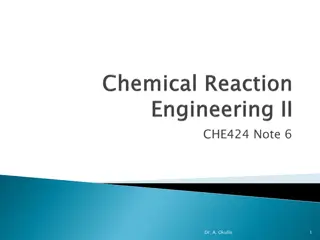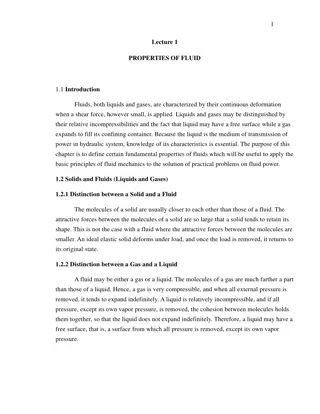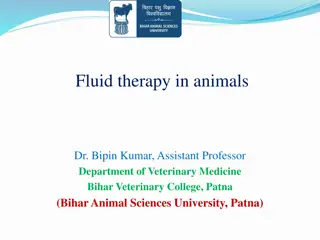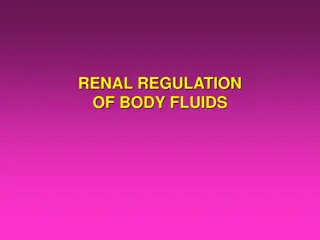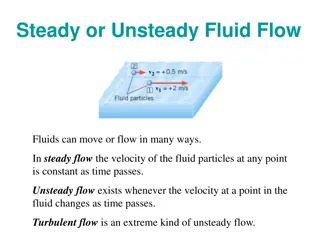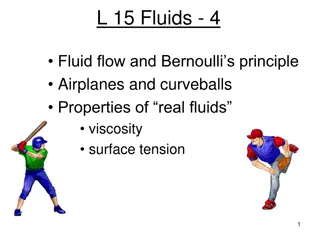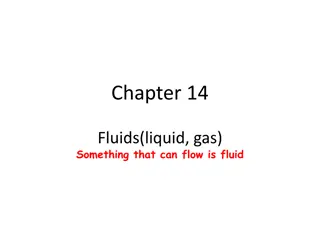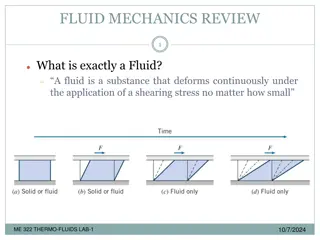BODY FLUIDS: Cerebrospinal Fluid
Cerebrospinal fluid (CSF) is crucial for supporting and protecting the brain and spinal cord. Learn about its functions, formation at choroid plexuses, and method of collection through lumbar puncture. Discover the importance of CSF circulation and indications for laboratory investigation. Also, explore contraindications for performing lumbar puncture to ensure safe collection. Gain insights into the significance of CSF sampling in diagnosing CNS infections, demyelinating diseases, CNS malignancies, and CNS hemorrhage.
Download Presentation

Please find below an Image/Link to download the presentation.
The content on the website is provided AS IS for your information and personal use only. It may not be sold, licensed, or shared on other websites without obtaining consent from the author.If you encounter any issues during the download, it is possible that the publisher has removed the file from their server.
You are allowed to download the files provided on this website for personal or commercial use, subject to the condition that they are used lawfully. All files are the property of their respective owners.
The content on the website is provided AS IS for your information and personal use only. It may not be sold, licensed, or shared on other websites without obtaining consent from the author.
E N D
Presentation Transcript
BODY FLUIDS: Cerebrospinal Fluid BODY FLUIDS: Cerebrospinal Fluid Dr. Amr S. Moustafa, MD, PhD Clinical Biochemistry Unit, Pathology Dept. College of Medicine, King Saud University
CSF Definition & Functions CSF definition: The liquid surrounding the brain and spinal cord It flows in subarachnoid area (the space between the arachnoid & pia matter) Functions: Physical support & protection Provides a controlled chemical environment supply & waste removal Intra- & extracerebral transport: Neuroendocrine function nutrient
CSF Formation & Circulation CSF is formed at the choroid plexuses & by the cells lining the ventricles. Normal blood brain barrier is important fot the normal chemistry results of CSF Rate of formation: 500 ml/day Mechanism of formation: Selective ultrafiltration of plasma Active secretion by epithelial membranes Mechanism of excretion (absorption): Excretion volume = production volume volume Absorption occurs at the arachnoid villi protruding through the dura to the venous sinuses of the brain constant CSF bloodstream
Method of CSF Sampling Traumatic tap (damage to blood vessel during specimen collection) blood in CSF
CSF Specimen Collection Obtained by lumbar puncture (At the interspace L3-4, or lower) Using aseptic technique CSF is separated into 3 aliquots: for chemistry & serology for microbioloy for cell count Immediate analysis It s a precious sample: Preserve any remaining sample
Contraindications for performing lumbar puncture: 1. Bleeding diathesis 2. Increased intracranial pressure 3. Infection at site of needle insertion
Indications for laboratory investigation of CSF: 1. CNS infection 2. Demyelinating diseases 3. CNS Malignancy 4. Hemorrhage in CNS
Examination of CSF: 1- Physical examination Normal CSF is: Colorless Clear Free of clots Free of blood If CSF is cloudy (turbid) microscopic examination: is usually due to leucocytes may be due to micro-organisms perform
Blood & Hemoglobin pigments in CSF Traumatic tap bright red color RBCS in decreasing number as the fluid is sampled Subarachnoid hemorrhage (SAH) Xanthochromia (hemoglobin breakdown pigments) = RBCs lysis & metabolism previously occurred (at least 2 hr earlier)
When would Xanthochromia indicate hemorrhage? If you exclude: 1. Prior traumatic tap 2. Hyperbilirubinemia (bilirubin > 20 mg/dL)
Examination of CSF: 2- Biochemical analysis of CSF Tests of interest: Glucose Protein Total Specific: Albumin Immunoglobulin Others (e.g. myelin basic protein; MBP) Lactate Glutamine (replaced by measuring plasma [ammonia]) The most reliable diagnostically & accessible analytically
Glucose in CSF Glc enters CSF via facilitative transporter (GLUT) CSF [glucose] is ~ 2/3 that of plasma 50 - 80 mg/dl A plasma sample must be obtained ~ 2-4 hr before CSF sample In hypoglycemia: [CSF glucose] may be very low In hyperglycemia: [CSF glucose] is raised. Measure CSF [Glucose]: immediately or preserve the specimen with and antiglycolytic e.g. fluoride ion
Abnormal CSF [Glucose] CSF [glucose] (hypoglycorrhachia): 1.Disorder in carrier-mediated transport e.g. TB meningitis, sarcoidosis 2.Active metabolism of glucose by cells or organisms: e.g. acute purulent, amebic, & fungal meningitis 3.Increased metabolism by the CNS e.g. by CNS neoplasm In viral meningitis CSF [glucose] is usually normal
Protein in CSF Proteins, mostly albumin are found in the CSF (0.15-0.45 g/L) Source of CSF proteins: 80% from plasma by ultrafiltration 20% from intrathecal synthesis
Abnormal CSF [total proteins] CSF [total protein]: Must be compared to the serum [protein] Useful nonspecific indicator of pathological states: Lysis of contaminant blood (traumatic tap) premeability of the epithelial membrane due to: Bacterial or fungal infection Cerebral hemorrhage production by CNS tissue in: Multiple sclerosis (MS) Subacute Sclerosing Panencephalitis (SSPE) Obstruction e.g. in: Tumors Abscess
CSF Albumin CSF Albumin (mg/dL) CSF serum albumin index: If < 9 = intact BBB = Serum Albumin (g/dL) Albumin is produced solely in the liver Its presence in CSF must occur through BBB
CSF Immunoglobulin CSF IgG/Serum IgG CSF IgG index: Normally: < 0.7 = CSF serum Albumin index CSF IgG can arise: from plasma cells within CSF & from the blood through BBB CSF [IgG] without concomitant in CSF [Alb] suggests local production of IgG: multiple sclerosis (MS) subacute sclerosing panencephalitis (SPEE)
What to do if CSF [protein] was detected? Perform electrophoretic separation If multiple banding of the IgG band is detected (oligoclonal bands): MS SSPE inflammatory diseases
Other Chemical Components of CSF CSF [Calcium], [Potassium] & [Phosphates] are lower than their levels in the blood CSF [Chloride] & [Magnesium] are higher than their levels in the blood Abnormal CSF [Chloride] marked in acute bacterial meningitis slight in viral meningitis & brain tumors
Normal composition of CSF Appearance Lymphocytes Polymorphs pH Total Volume Daily Secretion Clear ,Colorless <5/mm3 Nil 7.4 100 - 150 ml 450 - 500 ml Specific Gravity Protein Glucose 1.006 - 1.007 0.15 0.45 g/L 50 - 80 mg/dL (2.8-4.2 mmol/L) (>50% plasma level) 115 - 130 mmol /L 1.0 - 1.40 mmol/L 0.4 - 0.7 mmol/L 1.2 - 1.5 mmol/L 2.6 - 3.0 mmol/L Chloride Calcium Phosphorus Magnesium Potassium
Abnormal findings of CSF in some pathological conditions Parameter Condition Bacterial Meningitis (pyogenic) Tuberculous Meningitis Viral Meningitis Appearance Often turbid Often fibrin web Usually clear Predominant cell Polymorphs Mononuclear Mononuclear Cell count/mm3 90-1000+ 10-1000 50-1000 Bacteria In smear & culture Often none in smear None seen or cultured
Abnormal findings of CSF in some pathological conditions, continued.. Condition Parameter (reference range) Bacterial Meningitis (pyogenic) Tuberculous Meningitis Viral Meningitis Protein (0.15-0.45 g/L) Glucose (2.8-4.2 mmol/L) Chlorides (115 - 130 mmol/L) >1.5 ( ) 1-5 ( ) <1 (Normal) <1/2 plasma ( ) <1/2 plasma ( ) >1/2 plasma (Normal or slightly ) Normal or
Otorrhea & Rhinorrhea Otorrhea: leakage of CSF from the ear Rhinorrhea: leakage of CSF into the nose How to identify it as CSF? Measure -transferrin (a protein unique to the CSF)
TAKE HOME MESSAGE CSF is formed in the choroid plexus It is essential for the physical protection of the CNS The physical & chemical analysis of CSF is essential for diagnosis of certain diseases
